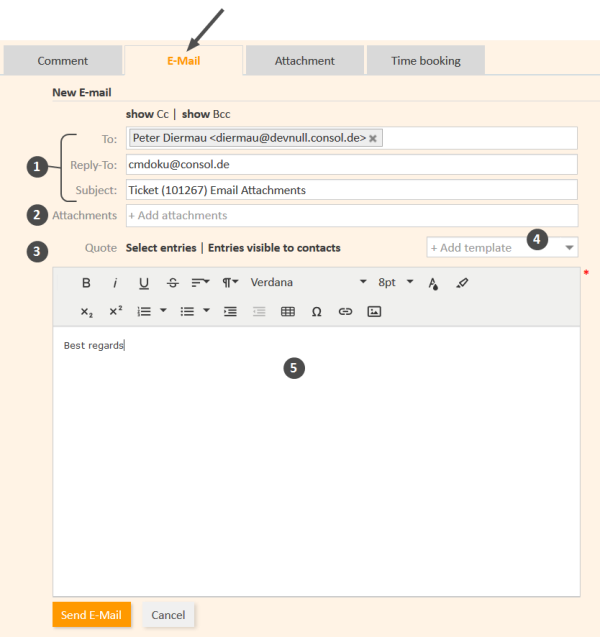Emails
The Web Client can send and receive emails related to cases. Emails are always sent from within the case they concern. You can send emails to the contact and to any recipient with a valid email address. All emails sent from the Web Client are displayed in the case history. If the recipient replies to the email, the reply is also added to the case history. The case history therefore provides an overview of all email communication, including attachments.
Sending emails
To draft the email click the Email link in the header of the history section. The background of the history section turns yellow to indicate that it is in edit mode. If the section is already in edit mode, you can also write an email by clicking the Email tab. Depending on your system configuration, the rich text editor might already contain a certain template, e.g., your signature. You can edit the text before sending the email.
Figure 68: Sending an email
- Standard email fields (1)
- To
This field contains the recipient of the email. In most CM systems, it is initially filled with the email address of the case's main contact (if provided). Depending on the system configuration, you see the email address and/or the name of the recipient. You can remove the recipient by clicking the little cross next to the name and you can add multiple recipients separated by a comma. As soon as you start typing the recipient's email address or name, the CM system suggests matching recipients. - Cc/show Cc
This field contains the recipients which should receive a copy of the email. If the Cc field is not displayed, click the show Cc link. - Bcc/show Bcc
This field contains the recipients which should receive a blind copy of the email. If the Bcc field is not displayed, click the show Bcc link. - Reply-To
This field contains the reply-to address used in the email. This is usually a system address. Do not change it! - Subject
This field contains the email subject. The subject is set automatically by the system. Do not change it! Otherwise the replies might not be correctly attached to the case.
- To
- Attachments (2)
Here you can select attachments to be sent with the email. You can only select attachments which are already added to the case or included in a selected template, i.e., it is not possible to upload a new attachment here. This field is hidden if the case does not have any attachments. - Quote (3)
Here you can quote communication entries (comments and emails) from the case history. You can either click Entries visible to the contact to select all communication entries which are marked with a class of text which is visible to contacts, or click Select entries to manually choose the communication entries which you want to quote. In the latter case, you have to click the entry in the case history (outside the pop-up window). The selectable entries are indicated by a scissors icon. - Add template (4)
Here you can select one or several templates for the email text. Depending on your system configuration, a standard template might be initially selected. You can select another template or edit the template text before sending the email. Please see Templates for a detailed description of templates. - Rich text editor (5)
This field contains the email body, i.e., the text which is sent. You can format the email text using the features of the rich text editor.
Draft your email and click Send Email to send it to the indicated recipients.
Replying to emails and forwarding emails
You can reply to and forward an email from the case history.
To reply to an email, open the Action menu of the desired email and click Reply / Reply all. The rich text editor is opened. The sender of the original email is automatically selected as a recipient in To: and the original email is quoted under in reply to. You can edit and send your email as described in Sending emails.
To forward an email, open the Action menu of the desired email and click Forward. The rich text editor is opened. The original email is quoted under Original Message and you have to specify the recipient in the To: field. You can edit and send your email as described in Sending emails.
Printing an email
You can print an email by clicking Print in the Action menu of an email. This opens the print dialogue of your operating system. If you have a PDF utility installed, you can choose to print the email to a PDF file. The printed output contains the email and some additional information about the email entry, i.e., the date and time of the entry, the case number and subject, and the author of the entry.
Retrying an email
If you send an email which cannot be delivered, e.g., because there is a problem with the mail server, the text This email was not delivered is displayed in the respective history entry. You can click Retry in the Action menu to make another attempt at sending the email.
Figure 69: Sending an email again

